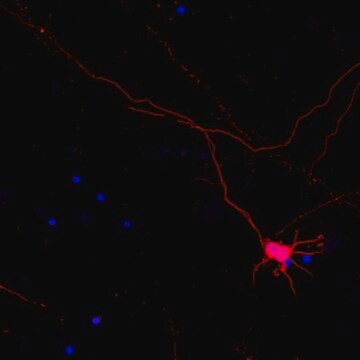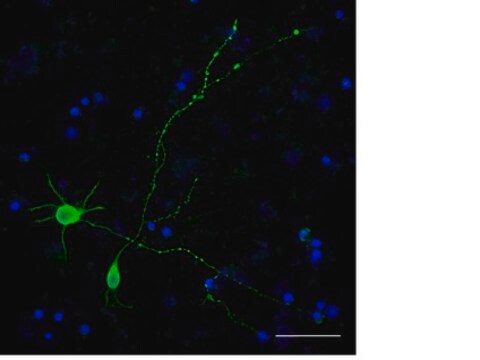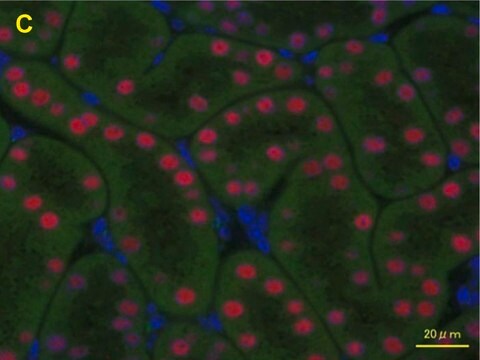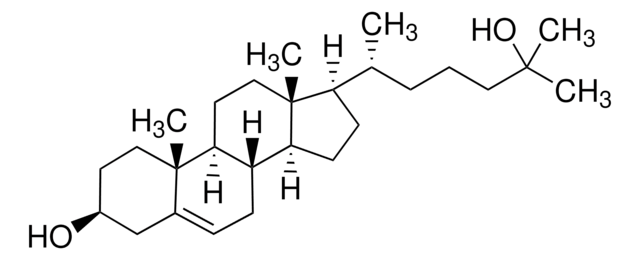ABN2300A4
Neuro-Chrom Pan Neuronal Marker Antibody-Rabbit, Alexa488 conjugate
Neuro-Chrom, from rabbit
Autenticatiper visualizzare i prezzi riservati alla tua organizzazione & contrattuali
About This Item
Codice UNSPSC:
12352203
eCl@ss:
32160702
NACRES:
NA.41
Prodotti consigliati
Origine biologica
rabbit
Livello qualitativo
Coniugato
ALEXA FLUOR™ 488
Clone
polyclonal
Reattività contro le specie
mouse, rat
Produttore/marchio commerciale
Neuro-Chrom
tecniche
immunocytochemistry: suitable
immunofluorescence: suitable
immunohistochemistry: suitable
Condizioni di spedizione
wet ice
modifica post-traduzionali bersaglio
unmodified
Descrizione generale
Antibodies to neuronal proteins have become critical tools for identifying neurons and discerning morphological characteristics in culture and complex tissue. While the labeling from classic histological techniques such as Golgi staining and modern molecular approaches such as GFP constructs yield excellent cytoarchitectural detail, these approaches are technically challenging and impractical for many neuroscience research needs. Neuron-specific antibodies are convenient precision tools useful in revealing cytoarchitecture, but are limited to the protein target distribution within the neuron, which may differ greatly from nucleus to soma to dendrite and axon. To achieve as complete a morphological staining as possible across all parts of neurons, Millipore has developed a polyclonal antibody blend that reacts against key somatic, nuclear, dendritic, and axonal proteins distributed across the pan-neuronal architecture that can then be detected by a single secondary antibody. This antibody cocktail has been validated in diverse methods, cell culture and immuno-histochemistry, giving researchers a convenient and specific qualitative and quantitative tool for studying neuronal morphology.
Specificità
Cat. # ABN2300A4 is specific to axons (neurites), dendrites, nucleus, and the cell body of neurons.
Reactivity with other species has not been determined.
Immunogeno
Epitope: Whole Neuron Marker
Applicazioni
Neuro-Chrom Pan Neuronal Marker-Rabbit, Alexa488 conjugate is an antibody targeting the Pan Neuronal Marker protein, validated for use in ICC, IHC & IF.
Research Category
Neuroscience
Neuroscience
Research Sub Category
Neuronal & Glial Markers
Neuronal & Glial Markers
Qualità
Routinely tested Rat E18 cortex primary neurons in Immunocytochemistry.
Stato fisico
Polyclonal antibody cocktail blend conjugated to Alexa Fluor™ 488 in PBS buffer with 15mg/mL BSA and 0.05% NaN3
Stoccaggio e stabilità
Maintain at 2-8°C for up to 1 year from date of receipt.
Risultati analitici
Control
Rat E18 cortex primary neuron cell culture or mouse adult brain cryosections.
Rat E18 cortex primary neuron cell culture or mouse adult brain cryosections.
Note legali
ALEXA FLUOR is a trademark of Life Technologies
Esclusione di responsabilità
Unless otherwise stated in our catalog or other company documentation accompanying the product(s), our products are intended for research use only and are not to be used for any other purpose, which includes but is not limited to, unauthorized commercial uses, in vitro diagnostic uses, ex vivo or in vivo therapeutic uses or any type of consumption or application to humans or animals.
Codice della classe di stoccaggio
12 - Non Combustible Liquids
Classe di pericolosità dell'acqua (WGK)
WGK 2
Punto d’infiammabilità (°F)
Not applicable
Punto d’infiammabilità (°C)
Not applicable
Certificati d'analisi (COA)
Cerca il Certificati d'analisi (COA) digitando il numero di lotto/batch corrispondente. I numeri di lotto o di batch sono stampati sull'etichetta dei prodotti dopo la parola ‘Lotto’ o ‘Batch’.
Possiedi già questo prodotto?
I documenti relativi ai prodotti acquistati recentemente sono disponibili nell’Archivio dei documenti.
Xinhua Zhan et al.
Neurology, 87(22), 2324-2332 (2016-10-28)
We determined whether Gram-negative bacterial molecules are associated with Alzheimer disease (AD) neuropathology given that previous studies demonstrate Gram-negative Escherichia coli bacteria can form extracellular amyloid and Gram-negative bacteria have been reported as the predominant bacteria found in normal human
Il team dei nostri ricercatori vanta grande esperienza in tutte le aree della ricerca quali Life Science, scienza dei materiali, sintesi chimica, cromatografia, discipline analitiche, ecc..
Contatta l'Assistenza Tecnica.








